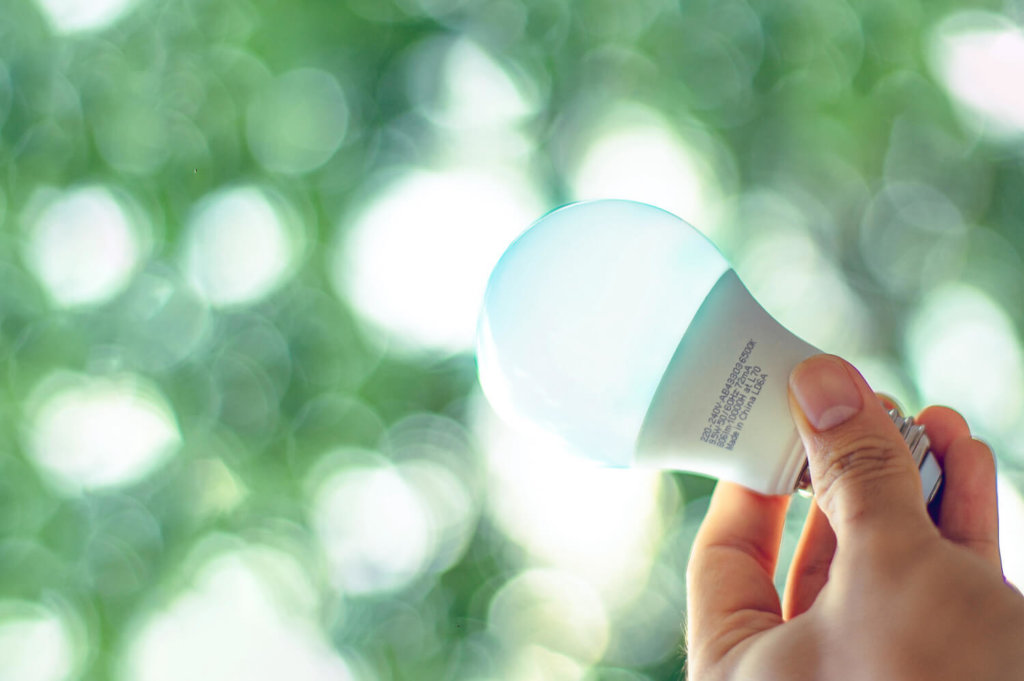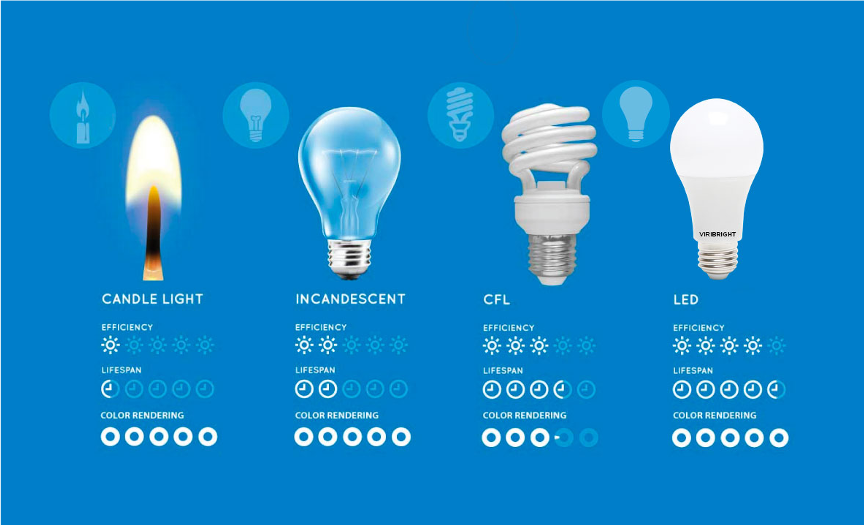
At Blue Raven Solar, we do everything we can to achieve our mission, which is to make homeowners’ lives better. There are a few ways we prefer to go about making their lives better. Those ways revolve around clean, renewable energy and the easy ways we can supplement that energy and the savings that come with it.
We’ve learned every homeowner likes to save money and help the environment, and fortunately, this is what we know best. Powering homes through solar energy is a great method for homeowners to save big on their utilities and protect the environment. This is one method of saving money and saving the environment, which is why we pose the following question:
Do LED Light Bulbs Really Make a Difference?

Light Bulb Basics
Before we jump into the overall value of an LED light bulb and the differences they can make, it is important to understand what types of light bulbs are available and the advantages and disadvantages of each. There are five commonly used light bulbs, but the three most common are incandescent, CFL, and LED bulbs.
Incandescent Bulbs
As the most used and most traditional bulbs, incandescent light bulbs have been around since 1889. These light bulbs, though, are seemingly quite cheap (only about a dollar per bulb) but are the most inefficient and will end up costing you the most. They only produce about 12 lumens (measurement of brightness) per watt, and they only have a lifetime of approximately 1,200 hours. This is about one and a half months of straight usage, and about three months of 12-hour days with the lights on.
Compact Fluorescent Lights (CFL)
The newest of these three bulbs, the Compact Fluorescent Light bulb, was invented in 1976. These bulbs have a spiral shape and emits a much whiter light than many other bulbs. These are more competitive when compared to LED bulbs because they have a lifetime of 8,000 hours and produce about 62 lumens per watt. They are also cheaper than LED bulbs, costing about two dollars per bulb.
CFL bulbs are the only light bulbs out of these three where the brightness cannot be adjusted, and they take a little while to get to their full brightness and might be somewhere lower than 62 lumens per watt. Additionally, these bulbs contain mercury, which can be extremely dangerous, and they contain enough to keep homeowners from wanting these in their homes, especially when it comes to disposing of them properly.
Light Emitting Diode (LED)
LED bulbs were invented in 1962, and we believe these light bulbs are the best option for financial savings and for the environment. With their adjustable brightness, multiple shape options, and an average of 83 lumens per watt, LED bulbs are generally the brightest, most efficient light bulbs available. A downside to LED bulbs is they are a bit more expensive up-front, at about four dollars per bulb, but the long-term savings with these bulbs are more than worth it. They can have anywhere from 20,000 to 50,000 hours of consistent lifetime, at a brighter output than CFL bulbs and without any dangerous chemicals.
Incandescent Bulbs:
- Invention date – 1889
- Current Price – ~$1
- Efficiency – 14 Lumens per Watt
- Lifetime – 1,000 hours
- Pros – Very cheap, can control brightness, white lighting
- Cons – Most inefficient, most costly over lifetime
Compact Fluorescent Lights (CFL):
- Invention date – 1976
- Current Price – ~$1
- Efficiency – 73 Lumens per Watt
- Lifetime – 10,000 hours
- Pros – Relatively cheap, efficient, and long lasting
- Cons – Take a little time to get bright, cannot control brightness, contain mercury, twisty shape makes them difficult to dispose
Light Emitting Diode (LED):
- Invention date – 1962
- Current Price – ~$2
- Efficiency – 70-120 Lumens per Watt
- Lifetime – 10,000 hours
- Pros – Can control brightness, have multiple shape options
- Cons – Most expensive
More Efficient, but More Expensive…
It is clear LED light bulbs last longer, are more efficient, have controlled brightness, and have multiple shape options, but are they worth the price? We think so. While replacing all your incandescent or CFL bulbs with new LEDs might take a hit to your bank account at first, it will save you money over time.
According to Energy Star, the average American home uses 40 light bulbs. With the average cost of electricity in the USA being eight cents per kilowatt hour, a 40 light bulb house, using 60-watt incandescent bulbs for 4.5 hours a day, will spend about $315 on electricity usage in a year. By making the switch to LED bulbs, a homeowner will reduce their yearly electricity cost to about $58.00. Thus, the 40 new LED light bulbs will pay for themselves before the first year is over. Over the 15-year lifespan, they will continue to save the homeowner money! That sounds like a return on your investment to us.

More Efficient and Better for the Environment
No doubt, we all love to save money, but helping the environment can also be an important influence in home improvement decisions. Luckily, LED light bulbs benefit the environment in several ways. They reduce waste because they are discarded less often — the amount of light produced by one LED bulb is equivalent to 5 CFL bulbs or 30 incandescent bulbs. In addition, if you discard your CFL bulbs incorrectly, you could be releasing mercury into soil, water deposits, or other areas which could have hazardous consequences to plants, animals, and humans.
LED light bulbs also help reduce your carbon emissions because they are more efficient and require less energy to produce similar and better light.
If every US household switched out one incandescent bulb to CFL, it would be like planting 400,000,000 trees or taking 800,000 cars off the road. Now, imagine this impact multiplied by the efficiency of LED light bulbs. One might suspect most homeowners have already made the switch to LED, but there are still 1.5 billion incandescent bulbs in use today. So, if you are still using incandescent bulbs, change them out to help the environment and save money.
According to the United States Department of Energy’s 2007 report that came with the Energy Independence and Security Act, over 20 years of LED lighting in place of incandescent lighting would prevent the construction of 40 new power plants, save over $265 billion, and reduce lighting electricity demand by 33 percent. We are almost at the 20-year mark, and there is no doubt we still have some improvements to make, but we are on a better trajectory. More and more homeowners are switching their incandescent bulbs for efficient, practical LED bulbs.

The Blue Raven Solar Way
Blue Raven Solar wants to help homeowners across the country save on their electricity bills, which is why we help them make the switch to solar energy. There is potential for more benefit, so when a customer purchases a solar system, we also offer them a new smart thermostat and 18 LED lightbulbs to help them save even more money and make a positive impact on the environment.
We know we can bring better, cleaner, more affordable energy to people all over the nation through solar power. We also want to provide useful information and resources for homeowners to save even more in smaller ways. LED light bulbs are a lighting path to a better future and a cleaner planet, where everyone saves a little more and breathes a little easier.
Learn more about solar systems and how they can save you thousands by reading: How much does solar save?
If these savings seem beneficial and you want to take advantage of them, you might consider making the switch to solar energy! You can talk with one of our experts to find out how much you can save by requesting a free, no-commitment savings report. With Blue Raven Solar, you can experience the future of energy today.
Sources:
- https://medium.com/@omegapacific/5-different-types-of-light-bulbs-32472c24bb70
- https://www.energy.gov/articles/history-light-bulb
- https://www.thesimpledollar.com/save-money/the-light-bulb-showdown-leds-vs-cfls-vs-incandescent-bulbs-whats-the-best-deal-now-and-in-the-future/
- https://www.sust-it.net/incandescent-bulbs-lumens-to-watts-conversion-led.php?fu=13&cu=us
- https://www.eia.gov/electricity/monthly/epm_table_grapher.php?t=epmt_5_6_a
- https://nepis.epa.gov/Exe/ZyNET.exe/P1003EIX.TXT?ZyActionD=ZyDocument&Client=EPA&Index=2006+Thru+2010&Docs=&Query=&Time=&EndTime=&SearchMethod=1&TocRestrict=n&Toc=&TocEntry=&QField=&QFieldYear=&QFieldMonth=&QFieldDay=&IntQFieldOp=0&ExtQFieldOp=0&XmlQuery=&File=D%3A%5Czyfiles%5CIndex%20Data%5C06thru10%5CTxt%5C00000007%5CP1003EIX.txt&User=ANONYMOUS&Password=anonymous&SortMethod=h%7C-&MaximumDocuments=1&FuzzyDegree=0&ImageQuality=r75g8/r75g8/x150y150g16/i425&Display=hpfr&DefSeekPage=x&SearchBack=ZyActionL&Back=ZyActionS&BackDesc=Results%20page&MaximumPages=1&ZyEntry=1&SeekPage=x&ZyPURL
- https://www.washingtonpost.com/lifestyle/home/why-you-should-switch-to-led-lightbulbs-right-now-before-the-law-requires-it/2018/01/16/c2d915f4-f0a2-11e7-b3bf-ab90a706e175_story.html




Sorry, the comment form is closed at this time.